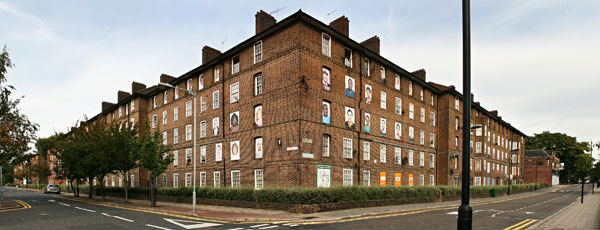
"I Am Here"
by Andrea Luka Zimmerman, Lasse Johansson and Tristan Fennell.

"I Am Here"
It is impossible to write about the photo-installation i am here without also elaborating, in quite some detail, on the context from within which the work emerged and where it was installed. That is because i am here addresses a particular socio-political as well as economical situation specific to where it is installed, on the façade of Samuel House, part of Haggerston & Kingsland Estate. The housing estate is located alongside Regents Canal in-between Kingsland Road and Victoria Park in Hackney, London. Over the past 10 years this area has become increasingly gentrified. As a consequence the transformation of the area surrounding Samuel House has been radical and the estate now finds itself wedged in-between luxury loft apartments and expensive live/work spaces.
Whilst this rapid transformation has been going on in the area, nothing much has changed on Haggerston & Kingsland Estate since the early 1980’s. That is, except from an ongoing steady decline due to lack of maintenance and a gradual emptying of the estate. Since at least 2004 no new residents have been accepted, and instead, vacated flats have been boarded up. This is mainly due to the fact that the future of the estate has been contested for nearly 30 years. Although there has been no lack of proposals promising to create a better future for the residents at Haggerston & Kingsland, none developed beyond the planning stages. However, in October 2007 the residents voted in favour of a stock transfer to L&Q housing association, and in September 2008 planning permission for the development was obtained. The estate is now scheduled for complete demolition and rebuild. All the current residents have been offered a flat in the new development and will be temporarily re-housed during the construction phase.
This history of decline and broken promises, of late played out amidst the rapid development surrounding the estate, forms the general background for the i am here project. To look in even greater detail into the context for the work, we need to return to April 2007, 5 months before the stock transfer vote. Without any prior warning bright orange boards were promptly fitted over the windows of all the vacated and empty flats on the estate. This rather bold visual statement even further underlined the dilapidation of the estate. The blocks dotted with orange boards rapidly turned into an object of curiosity, especially for the passers-by using the increasingly popular towpath along Regents Canal for daily commuting to and from work, or for weekend strolls to Victoria Park and Broadway Market.
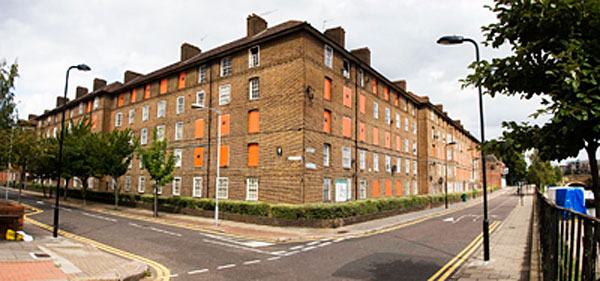
the site - before "I Am Here" was installed
Being long-term residents on the estate we suddenly found ourselves living in a local photo opportunity. A situation we became quite familiar with, as we frequently overheard, through our open windows facing the canal, people speculating about the estate, its possible future and state of decline. Often whilst documenting it with their camera or mobile phone. We felt that the orange boards had turned the facade into a projection screen for people’s fears and prejudices around estates, and the people living in them. We simply wanted to disturb what we perceived as a very one-way communication.
How could we as artists possibly intervene in this dynamic of being looked at and projected into? We decided to do it with the help of a photo-installation, replacing all the orange boards with large-scale photographic portraits of current and former residents of the estate. As to, so to speak, humanize the façade, complicate and return the gaze of the passers-by. Furthermore, we wanted to become an active part in the process that produces the visual environment of our increasingly gentrified neighbourhood. We asked ourselves, who and what is made visible and what is excluded in this rapidly changing urban environment, and for what purpose? i am here shows the faces of ordinary people so often excluded from the visual material produced to market an up-and-coming area by estate agents, developers, private landlords, local councils and other stakeholders . It was important for us to make this visual statement without imposing any particular community identity on the participants we were working with. That is the reason why we chose to title the project i am here instead of something else, for example: we are here.
When developing our ideas for i am here we were conscious that the work would have at least three distinct audiences. One would be constituted by the residents, an other by our landlord and yet another by the flow of people passing by the estate on the towpath of the canal. We were all too aware that the work would most certainly have very different meanings to each of them, not to mention how it would be received differently by the individuals constituting the above hypothetically identified audiences. Since the project required a substantial participation from of one of the above-identified audiences, the residents, our first step was to consult the residents in Samuel House to make sure we had their support. We went door knocking and got 98% signatures in support of the project – not necessarily a proof of the strength of our idea but if nothing else an indication of how strongly people felt about the orange boards.
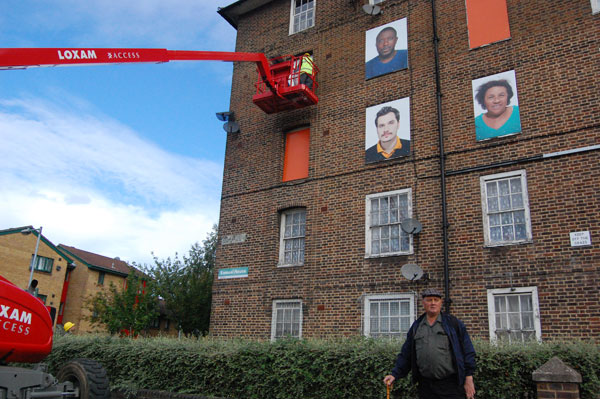
"I Am Here" being installed, Sept 2009
As we are now looking back on and try to think through i am here the one question that keeps returning is concerned with instrumentality. By instrumentality we mean the difference between understanding the role of art as purposeless, therefore autonomous and art understood as intrinsically relational. That is, not independent from the context within which it appears but dependent and specific to it. As we have seen i am here evolved directly out of a particular context and is not only intrinsically dependent on it but also addresses it directly. As such, we are in fact using i am here as an instrument to state an argument, albeit perhaps an obtuse one, in an ongoing debate. Doing so inevitably makes the work also vulnerable to be used as an instrument by others.
Is it a problem to open up art to be used instrumentally in this way or is it a possibility?
The framework of the gallery and museum automatically guarantees that whatever one places or performs within its boundaries becomes art. Outside of these institutions there are no such guarantees, less one manufactures them oneself either by authorizing the work purely by means of ones status as an artist, or by orchestrating the dissemination of the work in the media; through art journals; online groups; and not the least on the location where the work is installed. In other words, when practicing in the public domain, the interpretation of the artwork as art is not assured. Consequently the work may be appropriated and used by any of the stakeholders having vested interests in the context within which the artwork is located. It may turn out that there are parties wanting to claim the artwork for issues in no way related to the concept of the work itself but instead to further their own interests. These may range from commercial actors, interested in gaining publicity by proximity or association with the project. If possible and if desired they may be persuaded to become sponsors. There might also be other parties involved driven by ideological/political reasons, wanting for example to promote issues concerning social cohesion by route of the artwork. Not to mention the media and their incessant search for stories.
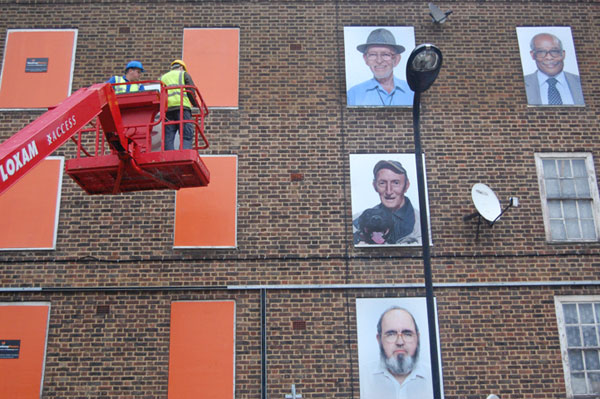
Thus the issue of instrumentality requires of the artist to pay close attention to the context framing the work. That is since the interpretation of the artwork inevitably will be intimately bound to it. Consequently context becomes something like an artistic material. However as an artistic material, context will remain a slippery one that never, unlike clay, will give itself up completely to the hands of the artist.
In spite of the apparent and seemingly unavoidable dangers of opening up artworks to used instrumentality, by placing them in the unruly social world, we see instrumentality as a possibility rather than a problem. Whereas the gallery and museum perform the important role of guaranteeing works to be interpreted as art and therefore allowing a highly specialized and precise discourse to exist, one may also see it as limiting artworks to be nothing but art. Placed in a wider social context artworks will inevitably be exposed to instrumental use but it also allows them to expand, participate in and address a much wider range of discourses. This, we believe, allows for artists a bit more freedom to directly engage with social situations and the people populating them and not just be reduced to comment on them from the safe space of the gallery.
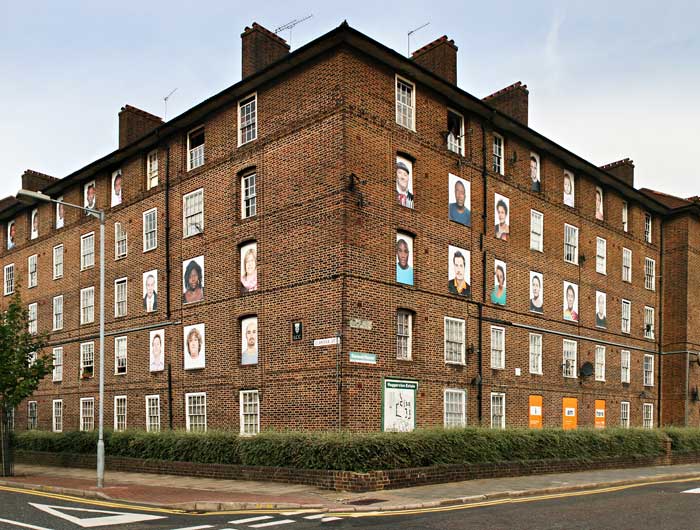
All images copyright Andrea Luka Zimmerman, Lasse Johansson and Tristan Fennell, and may not be used without permission.
http://www.fugitiveimages.org.uk/
about the artists:
‘i am here’ is produced by Fugitive Images, an artist collaboration founded in 2009 by Andrea Luka Zimmerman, Lasse Johansson and Tristan Fennell. Fugitive Images explores the subtle and haunting traces of memory and desire that weave together identities and communities, while seeking close and sustained collaborations within communities. Their aim is to develop reflective production methods and create imaginative works at the intersection of documentary, fiction, and collective dreaming.
Zimmerman uses filmmaking, photography and text to explore the grey zone between public and private memory. She has exhibited at festivals and galleries in the UK and internationally. Her work is distributed by the LUX.
Johansson uses film and installation to explore the formation of public spaces and the identities they give rise to. He has curated large-scale public art works, most notably Contemplation Room, Copenhagen.
Fennell works with photography and installation to explore the spaces between individual, community and surrounding urban landscapes. His work has been exhibited in various festivals and galleries in Dublin, Tokyo and Singapore.
Johansson and Fennell are recent graduates of Goldsmith’s MA at the Centre for Urban Culture and Research, and have collaborated on previous projects. Zimmerman completed a practice based PhD at Central St. Martins College of Art in 2007.
©Fugitive Images 2009 All rights reserved.